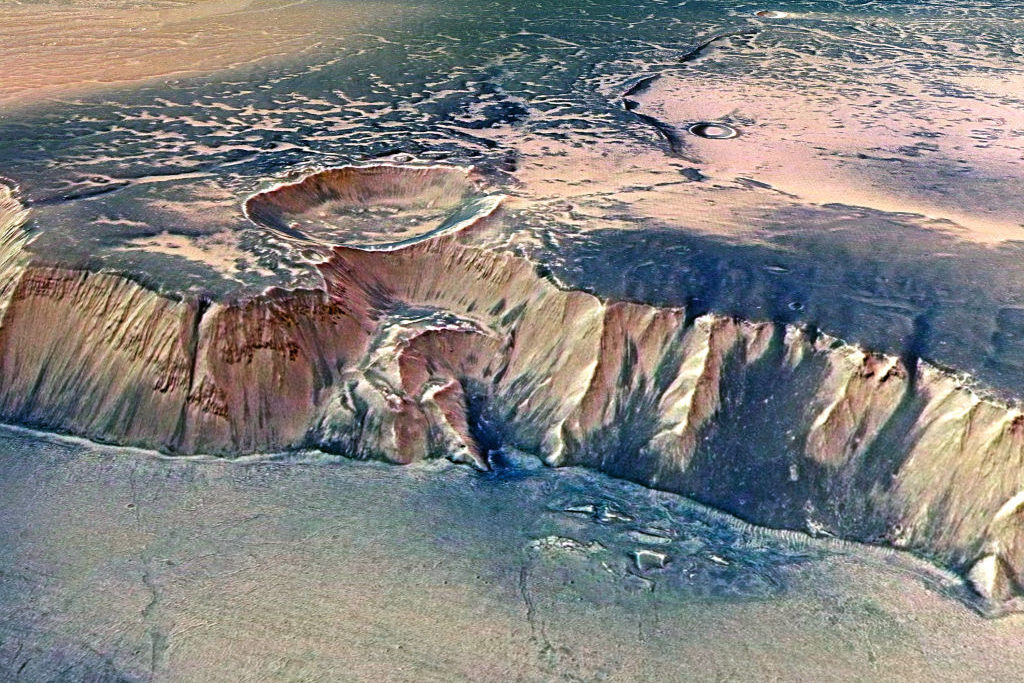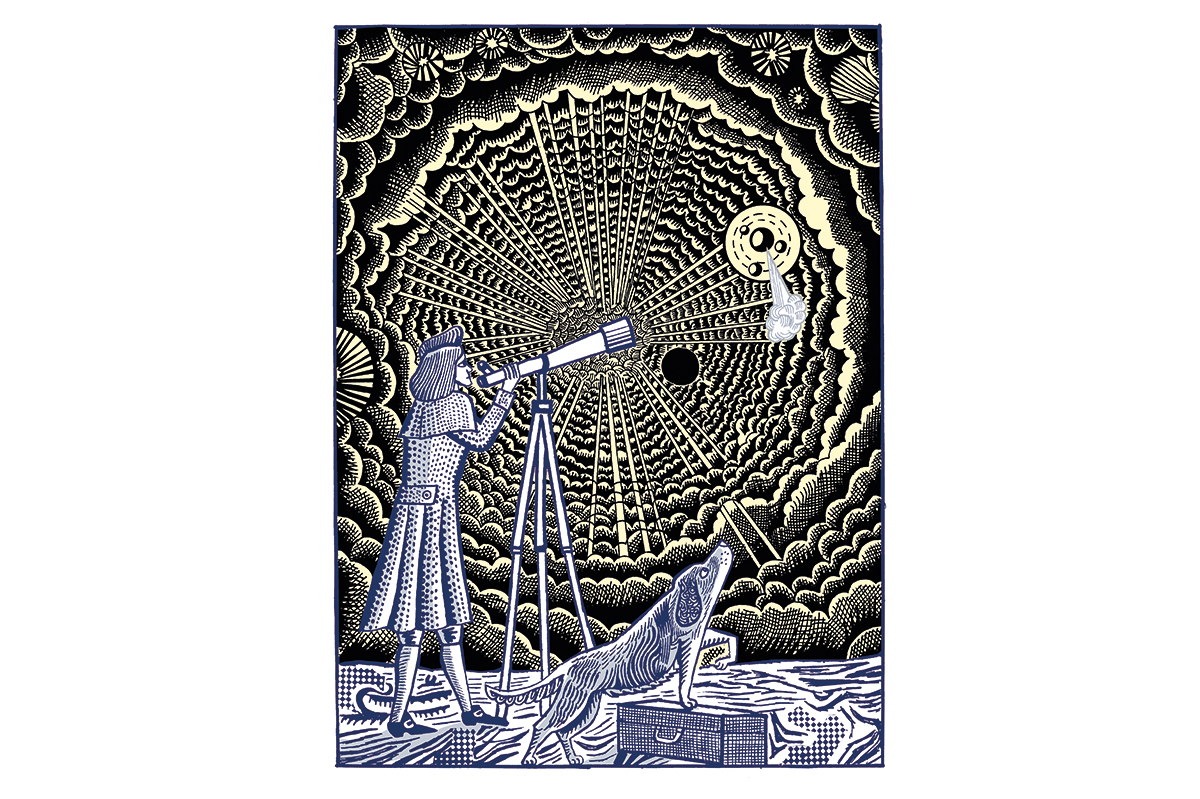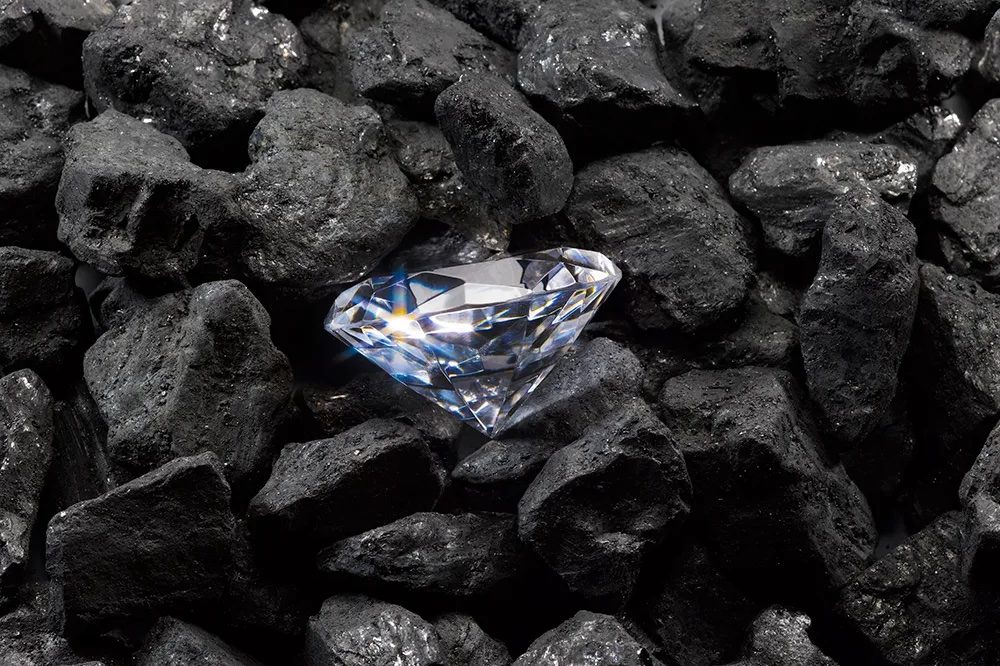The American businessman and astronomer Percival Lowell first popularized the notion of life on Mars in 1906 when he described vast canals observed on the planet, some spanning the equivalent distance of Boston to San Francisco. He believed an intelligent Martian civilization was in peril, their world drying out and dying, and they had constructed as a planet-wide irrigation system to move water from Mars’s polar ice caps to the rest of the planet.
American folklore has it that the idea of Martian intelligent life was so pervasive that a 1938 radio drama of H.G. Wells’s War of the Worlds, about a Martian invasion, ignited mass panic when millions of people believed it was a real newscast. Delightful as the legend may be, it turns out most likely not true, rather an early example of fake news malfeasance invented by the newspaper industry at the time to discredit radio, which had been siphoning off advertising dollars. A good reminder the next time mainstream media launches bazookas at popular, online content creators: they’ve been doing that to upstart competition for almost 100 years.
But by the 1970s, it was pretty much settled that Mars was a lifeless wasteland, the New York Times even declaring in headlines Mars to be a dead planet. Scientists believed even Earth’s most hostile habitats couldn’t sustain life. But, to be sure, a team was dispatched to Antarctica where, to everyone’s surprise, they found thrilling microorganisms there. As a result, life-detection experiments were approved for the 1976 Viking mission, the first rovers to touch down on Mars.
It resulted in perhaps the most profound scientific discovery of all time that you’ve never heard of. Life was discovered, at least by the pre-mission criteria set forth for the experiment. Known as the labeled release experiment, the two Viking rovers, touching down 4,000 miles apart on the red planet, conducted the test a total of four times. The experiment involved placing a nutrient-rich substrate on top of a clump of Martian soil. The substrate was laced with radioactive carbon. Any life, as we know it, that consumes organics produces carbon dioxide gas. The rovers then monitored for soil for the release of the radioactive carbon gas, indicating something had consumed and metabolized the substrate. The results each time were positive and nearly identical. To be sure, the rovers then heat-sterilized the same clumps of soil to temperatures that would kill any microbes living there. After sterilization the experiment was repeated and each time no gas was detected, suggesting they had killed whatever was living in the soil.
Despite the results meeting all of the pre-mission criteria for declaring life existed on Mars, it stirred an immediate backlash within NASA. Scientists claimed it must be a mistake because there’s no water on Mars and water is required for life as we know it. Skeptics also claimed the reaction may have been chemical, not biological, and the heat sterilization may have destroyed whatever chemical agent that caused the gas release. However, when the experiment was conducted on Martian soil that had been stored for 90 days, it also produced a negative result. The storage environment would not have damaged any chemical compounds but would have killed off microbes.
Water, of course, has since been discovered on Mars, lots of it. Scientists have also discovered organisms on Earth, now called extremophiles that can survive in far more hostile environments than Antarctica, and even Mars, such as inside a scolding, toxic gas vents at the bottom of the ocean, lakes of acid, and even in the vacuum of space, like those adorable tardigrades.
Even more compelling, scientists have discovered methane in Mars’s atmosphere, an almost certain sign of microbial life. Methane degrades rapidly in atmospheres and must be constantly replenished either by geologic or biological processes. The geological explanation would be volcanism, but we’ve never seen a volcano erupt on Mars. More intriguing, the levels of methane in the Martian atmosphere are seasonal, increasing in summer and decreasing in winter suggesting, if there is life on Mars, there is a seasonal die-off, just like on Earth.
Any scientist in any field would confirm that the logical, proper next step for such a provocative positive result such as the 1976 Viking experiment would be an immediate follow-up. There have been 55 missions to Mars, 26 of them successful, and this has never even been attempted. We have two active rovers on Mars presently, Curiosity and InSight, with a third launching next year. None, including the planned $2.5 billion Mars 2020 mission, has life detection instruments. The rovers are actually searching for habitability, not life itself. Mars 2020’s rover is nearly identical to Curiosity and described as ‘an astrobiology-geared mission to look at surface geology and assess past and present habitability and the potential for preservation of biosignatures.’
The ‘potential for preservation’? Why not look for the biosignatures themselves? By early 2021 we will have nearly $10 billion of taxpayer-funded robots creeping around Mars testing soil samples for complex organic compounds that would support life, while, right under their wheels could be — probably — already a teeming ecosystem of microbes. It’s literally the only question any taxpayer cares about, so why is NASA so afraid of finding Martian bugs?
It’s not just the rovers. NASA currently has three orbiters around Mars, with more planned, with none equipped to search for fossil fuel deposits, another near confirmation that life exists, or once existed, there.
Dr Patricia Ann Straat, who worked on the labeled release experiment in 1976, has a book out this year, To Mars With Love, about the Viking mission. In recent interviews, she’s also completely dumbfounded that no follow-up experiment has occurred, claiming she and other scientists have sent countless proposals to NASA with each being ignored.
I think we all know why. Government money is a drug and NASA is on a bit of a bender at the moment. Less harsh critics might call it a ‘Renaissance’. But if the government-funded space agency simply answered the question the entire planet wants to know, how much longer would this spending bonanza continue? President Trump has outed himself as a fan of space exploration. And the public loves the Mars missions. As far as bloated government agencies go, NASA tends to have some of the best PR. Americans were utterly charmed by images of Pluto from the recent New Horizons mission, and awed earlier this year by the first image of a black hole. Crowds even gathered in Times Square to watch the 2012 Curiosity rover landing broadcast on the Jumbotron. But it seems more and more that, with Mars, we’ve just got the world’s most long and expensive episode of Shark Tank. Or perhaps the reason ABC doesn’t have a live action WALL-E planned is NASA’s been doing it for years. But will the public eventually catch on and begin to feel as though they’re being blue-balled on a global scale?
Confirming the 1976 experiment would only be the first step in answering the big question and immediately would raise a much larger one. Earth and Mars have been exchanging material for their entire existence. Life on Earth could have been seeded by life on Mars, or vice versa, in a process known as panspermia. If the former were the case, then, are we actually Martians? The other, more profound, possibility is that Martian microbes are entirely unrelated to life on Earth, which would mean life arose at least twice, independently, in our own solar system. That alone would completely change our understanding of the universe.
NASA may have another reason for not repeating the label release experiment, one they aren’t being forthright about. It’s possible they simply screwed up big time by waiting so long. Since 1976, our missions have almost certainly contaminated Mars with microbial hitchhikers from Earth which, if they can survive there, because of Mars’s massive dust storms have most likely spread across the entire planet by now, according to scientists.
This means no similar experiment done by rovers will likely satisfy all earth-bound scientists as conclusive evidence of native life on Mars. We may be stuck with an evolving cast of adorable robots for the foreseeable future who don’t really tell us anything new. A manned mission is not on the table. NASA also raised eyebrows in the Mars community almost 20 years ago when it quashed the Mars One proposal by Dr Robert Zubrin, president of the Mars Society and perhaps the most vocal and active Mars manned mission activist. Dr Zubrin’s plan included a series of missions to drop supplies and habitats on Mars before humans arrived, that would immediately beginning manufacture fuel on Mars for the return mission. It came in cheaper and faster than many of Mars’s current unmanned missions.
Cheap, fast and sensible aren’t words any government agency likes to hear. Martian life-hunters are left with one other option, returning soil samples to Earth. This, too, is currently not technologically possible and vastly more expensive than other missions would have been. It also poses a very serious concern for scientists, one straight out of science fiction: we don’t know if there will be organisms or viruses that are lethal. NASA could wipe out life on Earth, in the extreme case.
Thankfully, at the current rate, it won’t be NASA that brings about the end times. More likely, as private entrepreneurs inject new enthusiasm into space exploration, it’ll be a billionaire playboy like Richard Branson or a pot-smoking billionaire non-playboy like Elon Musk.
Or, of course, China.


























